

Key Findings
- Two new 1-day LPE exploits were used by the Raspberry Robin worm before they were publicly disclosed, which means that Raspberry Robin has access to an exploit seller or its authors develop the exploits themselves in a short period of time.
- Raspberry Robin is continually updated with new features and evasions to be even stealthier than before.
- Raspberry Robin slightly changed its communication method and lateral movement to avoid being caught by behavioral signatures implemented based on its previous version.
- Raspberry Robin is spread with a new delivery method, disguising as a legitimate Windows component.
Introduction
Raspberry Robin is a widely distributed worm first reported by Red Canary in 2021. Its capabilities and evasions in addition to its very active distribution made it one of the most intriguing malware out there. We at Check Point Research published an article a couple of months ago using Raspberry Robin as an example of identifying and mitigating different evasion behaviors.
Raspberry Robin is part of a much larger malware ecosystem and acts as an initial access broker to additional malware deployment by other crime groups. The different crime groups associated with Raspberry Robin include EvilCorp, TA505 and others.
Since last October, we have seen large waves of attacks against our customers worldwide. Since our last report, it is clear that Raspberry Robin hasn’t stopped implementing new features and tricks that make it even harder to analyze.
Most importantly, Raspberry Robin continues to use different exploits for vulnerabilities either before or only a short time after they were publicly disclosed. Those 1-day exploits were not publicly disclosed at the time of their use. An exploit for one of the vulnerabilities, CVE-2023-36802, was also used in the wild as a 0-day and was sold on the Dark Web.
Flow
In past campaigns, Raspberry Robin had several initial access vectors, leading to the main sample. The most prevalent one is via an LNK disguised as a thumb drive or a network share.
In this campaign, the attack flow started from archive files named File.Chapter-1.rar (we also found other names such as File_Part-1.rar or Part.File-1.rar) which were downloaded from Discord as an attachment.
Those archives contained the following items:
- OleView.exe, a legitimate and signed Microsoft executable.
- aclui.dll, a signed file, but the signature is not valid.
OleView.exe is used to load the malicious DLL, which is a packed Raspberry Robin sample that it calls from the main function. We found several unique unused export function names for those DLL samples that lead to kernel32.Sleep API:
BodsuwtubestdHnitEalEsneataysxxtEaipifEeetoioTaretxopnnevnNtitx
Attackers commonly choose Oleview.exe as a target for side-loading, primarily because it doesn’t typically exist on the disk by itself and requires a DLL to function. Therefore, it’s considered normal behavior to find Oleview.exe alongside a DLL brought to disk in a random directory and executed together. Additionally, because the DLL files are signed by Microsoft, they are inherently more trusted by some security solutions.
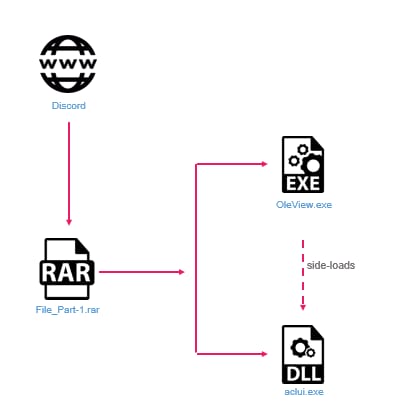
Raspberry Robin exploits
Introduction
Raspberry Robin has multiple ways of escalating its privileges which we reported in earlier blogposts. One way is to use kernel LPE exploits. Those exploits are stored encrypted with an RC4 key and are used only if the victim’s computer is vulnerable to those exploits. This means that Raspberry Robin will try to use the exploits only for specific Windows versions and build numbers. In the new samples, the malware injects the kernel exploits into cleanmgr.exe (in former samples it was into winver.exe) using the KernelCallbackTable injection method (used in the previous samples as well). Raspberry Robin injects a unique loader that resides in memory and loads an external PE which is the exploit. Interestingly, one of the exploits has changed since the last version and we identified it as targeting the CVE-2023-36802 vulnerability.
CVE-2023-36802 overview
CVE-2023-36802 is a Type Confusion vulnerability in Microsoft Streaming Service Proxy that allows a local attacker to escalate privileges to SYSTEM (Local Privilege Escalation). The vulnerability is triggered when one of the following IOCTLs (IOCTL_FRAMESERVER_PUBLISH_TX, IOCTL_FRAMESERVER_CONSUME_TX, IOCTL_FRAMESERVER_CONSUME_RX) is performed on the mkssrv device. This is after sending an IOCTL such as IOCTL_FRAMESERVER_INIT_CONTEXT that initializes the FsContext2 field to an object of type FsContextReg.
The vulnerability was disclosed back on September 12 and was declared to have been exploited in the wild for some time before it was used as a 0-day, but no information was given about the group that used it.
A blogpost by Cyfirma revealed that an exploit for CVE-2023-36802 was sold on Dark Web forums in February 2023. This was seven months before Microsoft and CISA released an advisory on active exploitation.
Vulnerability timeline:
- February 2023: An exploit for CVE-2023-36802 is sold on Dark Web forums.
- September 12, 2023: CVE-2023-36802 is patched and publicly disclosed, and reported to have been seen in the wild.
- October 2023: Raspberry Robin starts to use an exploit for CVE-2023-36802.
- October 10, 2023: Valentina Palmiotti publishes details of CVE-2023-36802 and its exploitation.
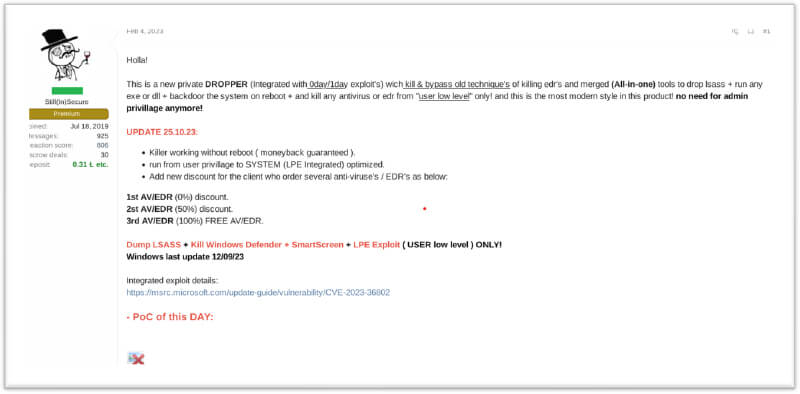
Exploit flow
The exploit, relevant to Windows 10 up through build number 22621, starts with initializing a main structure. The main structure looks like this:
main_struct {
dword version_less_than_19044_flag
dword token_offset
dword previousmode_offset
qword system_eprocess_addr
qword cur_eprocess_addr
}
The values for the Token offset and the PreviousMode offset are based on the Windows version which the malware checks by comparing to OSBuildNumber variable from the PEB.
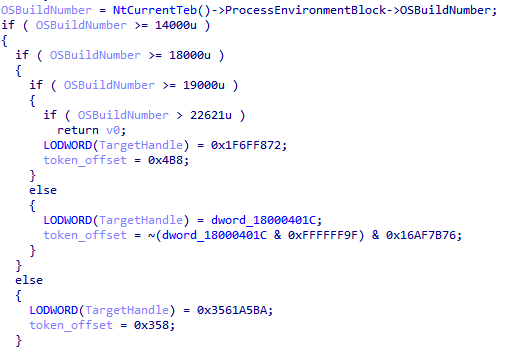
The EPROCESS addresses are retrieved by using a NtQuerySystemInformation API and a couple of undocumented, but well-known structures SYSTEM_HANDLE_INFORMATION and SYSTEM_HANDLE_TABLE_ENTRY_INFO. This is a known technique for leaking kernel object addresses.
The malware then generates a random pipe name based on a UUID by using the APIs UuidCreate and UuidToStringW. From this point, the flow differs depending on if the Windows version is lower than 19044 or higher.
For more information on why two flows are needed and what occurs in each one, read the great explanation by Google Project Zero.
Even though the flow is similar to the one described in the Google Project Zero blog and the fact that this exploit was used in the wild as a 0-day, we don’t have any evidence that Raspberry Robin used it as a 0-day, only as a 1-day. Therefore, we started to analyze files before the public disclosure of this vulnerability.
Past Exploitations
After looking at samples of Raspberry Robin prior to October, we found that it also used an exploit for CVE-2023-29360. This vulnerability was publicly disclosed in June and was used by Raspberry Robin in August. Even though this is a pretty easy vulnerability to exploit, the fact that the exploit writer had a working sample before there was a known exploit in GitHub is impressive as is how quickly Raspberry Robin used it.
This exploit also has the same loader and the same obfuscation scheme for the strings as the CVE-2023-36802 exploit and the flow is similar. Interestingly, this vulnerability is also in the mskssrv.sys, meaning the exploit writer is working on this driver. We may see other vulnerabilities in the driver being exploited in the wild.
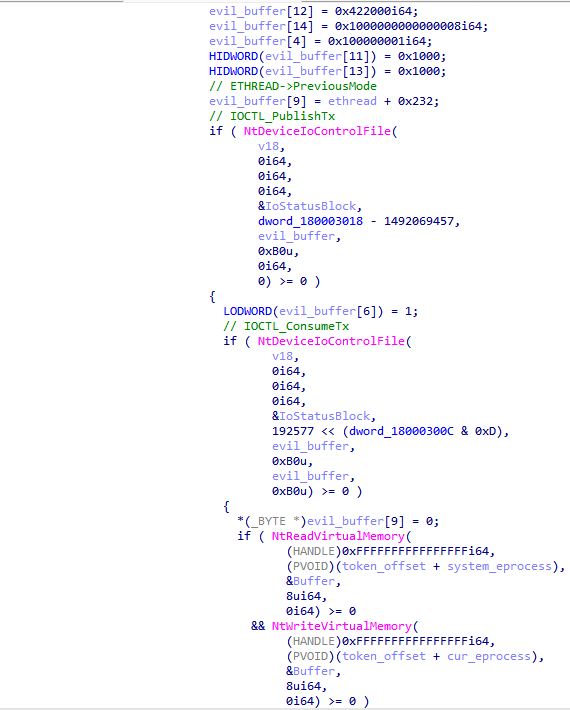
In 2022, Raspberry Robin used an exploit for CVE-2021-1732 a year after it was publicly disclosed. For CVE-2023-36802 it took almost 2 months, and with CVE-2023-36802 it took less than a month. Raspberry Robin is reducing the time it takes to utilize the exploits for Privilege Escalation. This helps the malware take advantage of the fact that people don’t update Windows too often and gives it more time to exploit the vulnerability.


Malware Overview
The flow of Raspberry Robin is still largely unchanged, with multiple stages stored in memory in a custom format that are unpacked and run without the headers section. The code in all stages is heavily obfuscated in the same way, including the main payload itself. The main anti-analysis stage still contains the methods it had in the previous version but as in the main payload, the malware’s authors added some new features which we will now discuss.
New anti-analysis methods
Raspberry Robin added some new features that it uses to decide whether to get to the main stage in different stages:
- In the first stage, Raspberry Robin checks if the APIs
GetUserDefaultLangIDandGetModuleHandleWare hooked. It does this by comparing the first byte of the API to 0xb8 which means those APIs were hooked. This is because the original byte of those APIs should be 0x48 (which means the jmp opcode) as in the following image.
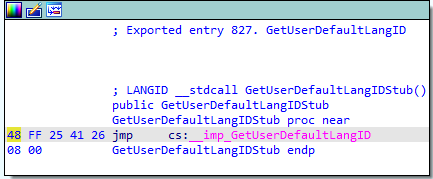
runlegacycplelevated.exetermination –RunLegacyCPLElevated.exeis a legitimate executable associated with the User Account Control (UAC) feature in Windows. It is used to elevate the privileges of Control Panel items (CPL) that require administrative permissions. Malware often tries to avoid detection by interfering with system processes. Raspberry Robin uses different techniques in an attempt to elevate its privileges, and some of them involve UAC bypasses. Raspberry Robin probably tries to terminate this process because it wants to perform malicious actions with elevated privileges without triggering UAC prompts.runonce.exetermination – Raspberry Robin persistence involves being written to theRunOnceregistry key. Therefore, after the computer is rebooted, the malware is executed by therunonce.exeprocess. To cover its tracks, Raspberry Robin terminates therunonce.exeprocess.NtTraceEventhooking – EDR products have the option of using multiple sources to collect information on a Windows operating system. One of these log sources is ETW (Event Tracing for Windows). ****TheNtTraceEventAPI is the central switching point for writing an event through ETW. Therefore, to bypass the ETW Raspberry Robin patches theNtTraceEventAPI not to do anything when it is being called.
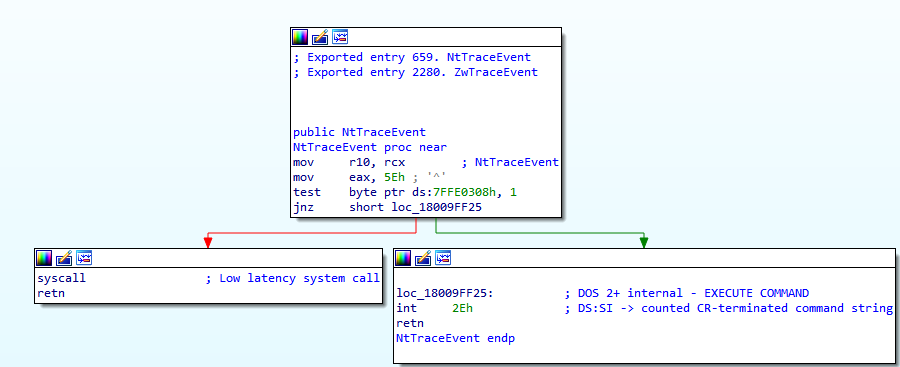
New Evasion Tricks
- Shutdown evasion – To ensure that Raspberry Robin is not prevented from finishing its job by a system shutdown, it implements two routines, each in a different thread it creates. Those threads are hidden by the API
NtSetInformationThreadwithThreadHideFromDebuggerargument upon which we elaborated in our previous blogpost. In the first thread, the malware calls in a loop to the APIAbortSystemShutdownWthat stops a system shutdown that was initiated. The second thread creates a window with a WNDPROC callback that calls theShutdownBlockReasonCreateAPI. This API indicates that the system cannot be shut down and sets a reason string to be displayed to the user if a system shutdown is initiated.
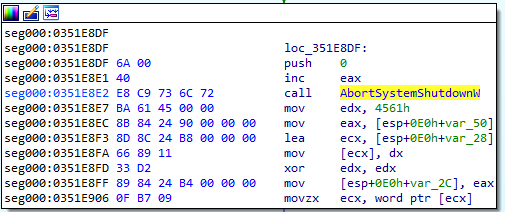
- Remote Desktop check – Raspberry Robin also checks if the victim’s computer is a remote desktop or not. It does that by checking 3 things:
- Calls the API
GetSystemMetricswithSM_REMOTESESSIONas an argument. If the value is nonzero then the current session is remotely controlled.
- Queries the value in
HKLM\System\CurrentControlSet\Control\Terminal Server\GlassSessionId. If the value is the same as the localSessionIdthen the victim’s computer is not remote-controlled. - Searches files in the path
\\tsclient\c. Thetsclientfolder on Windows typically relates to Remote Desktop Services (RDS) or Remote Desktop Connection (RDC). This folder is used to store information related to remote connections and configurations. Therefore, if the malware finds files in this directory, the computer is remote-controlled.
- Calls the API
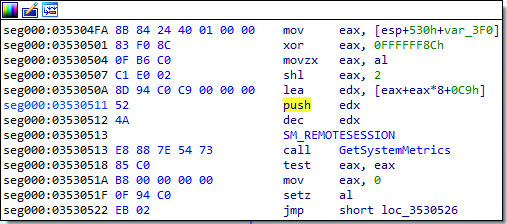
- Stop running in case of UWF filter driver – A Unified Write Filter (UWF) filter driver is a component designed to protect the integrity of a system’s directories by redirecting write operations to a virtual overlay, preventing permanent changes to the underlying storage. It’s commonly used in scenarios where a system needs consistency, such as in embedded systems, kiosks, or thin clients. Raspberry Robin checks if there is any driver by using a COM object and the following query:
“Select * from UWF_FILTER”. If it finds an object, the malware goes straight to cleaning up and rebooting.
Lateral Movement
Raspberry Robin slightly changed its lateral movement logic. Instead of using PsExec.exe, it uses PAExec.exe which it downloads straight from the official website https://www.poweradmin[.]com/paexec.exe. PAExec is designed to allow administrators to run processes on remote systems. It shares similarities with PsExec but the primary difference is that PsExec was developed by Sysinternals (Microsoft) and is widely used and recognized in the IT community for remote process execution. On the other hand, PAExec is a tool developed by PowerAdmin LLC and is less well-known. The other parts of the Lateral Movement by Raspberry Robin stayed the same. For example, the payload to be executed is still a self-extracting package and the config is in the same template and syntax.
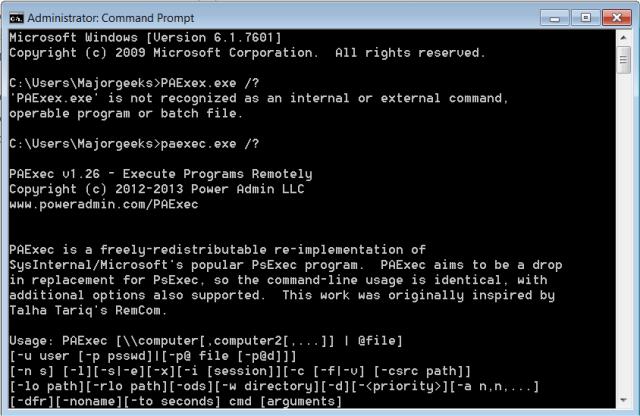
Communication
The flow of Raspberry Robin’s communication method has changed slightly. It starts with trying to contact legitimate and well-known tor domains and checking if it gets any response. If there is no response, Raspberry Robin doesn’t try to communicate with the real C2 servers.
The list of the tor domains:
juhanurmihxlp77nkq76byazcldy2hlmovfu2epvl5ankdibsot4csyd.onion protonmailrmez3lotccipshtkleegetolb73fuirgj7r4o4vfu7ozyd.onion hctxrvjzfpvmzh2jllqhgvvkoepxb4kfzdjm6h7egcwlumggtktiftid.onion guardian2zotagl6tmjucg3lrhxdk4dw3lhbqnkvvkywawy3oqfoprid.onion 4inahjbeyrmqzhvqbsgtcmoibz47joueo3f44rgidig6xdzmljue7uyd.onion p53lf57qovyuvwsc6xnrppyply3vtqm7l6pcobkmyqsiofyeznfu5uqd.onion ncidetfs7banpz2d7vpndev5somwoki5vwdpfty2k7javniujekit6ad.onion blkchairbknpn73cfjhevhla7rkp4ed5gg2knctvv7it4lioy22defid.onion darkfailenbsdla5mal2mxn2uz66od5vtzd5qozslagrfzachha3f3id.onion vww6ybal4bd7szmgncyruucpgfkqahzddi37ktceo3ah7ngmcopnpyyd.onion ciadotgov4sjwlzihbbgxnqg3xiyrg7so2r2o3lt5wz5ypk4sxyjstad.onion duckduckgogg42xjoc72x3sjasowoarfbgcmvfimaftt6twagswzczad.onion bbcnewsd73hkzno2ini43t4gblxvycyac5aw4gnv7t2rccijh7745uqd.onion zkaan2xfbuxia2wpf7ofnkbz6r5zdbbvxbunvp5g2iebopbfc4iqmbad.onion torbox36ijlcevujx7mjb4oiusvwgvmue7jfn2cvutwa6kl6to3uyqad.onion wasabiukrxmkdgve5kynjztuovbg43uxcbcxn6y2okcrsg7gb6jdmbad.onion 2gzyxa5ihm7nsggfxnu52rck2vv4rvmdlkiu3zzui5du4xyclen53wid.onion reddittorjg6rue252oqsxryoxengawnmo46qy4kyii5wtqnwfj4ooad.onion zerobinftagjpeeebbvyzjcqyjpmjvynj5qlexwyxe7l3vqejxnqv5qd.onion onionamev33r7w4zckyttobq3vrt725iuyr6xessihxifhxrhupixqad.onion nytimesn7cgmftshazwhfgzm37qxb44r64ytbb2dj3x62d2lljsciiyd.onion brave4u7jddbv7cyviptqjc7jusxh72uik7zt6adtckl5f4nwy2v72qd.onion archiveiya74codqgiixo33q62qlrqtkgmcitqx5u2oeqnmn5bpcbiyd.onion facebookwkhpilnemxj7asaniu7vnjjbiltxjqhye3mhbshg7kx5tfyd.onion fpfjxcrmw437h6z2xl3w4czl55kvkmxpapg37bbopsafdu7q454byxid.onion
Raspberry Robin then randomly chooses a domain from another list that contains 60 hardcoded onion addresses. The big difference from previous samples is that the domains are V3 onion addresses and not V2. It might be because V2 onion addresses are officially deprecated and the Tor Browser no longer supports them in its latest version. The data being sent is still very similar to the previous version with a bit’s worth of data added as the processes tree of the malware, and the file names inside the C:\ directory. This data is encrypted with RC4 and then b64 encoded as the path in the communication with the C2. The communication between Raspberry Robin and the C2 is performed through a TOR module being injected into another process as rundll32.exe or regsvr32.exe.
Version comparison
| Previous version | Current version | |
|---|---|---|
| Delivery method | Mostly USB drives | Discord RAR files |
| Exploits injection process | winver.exe | cleanmgr.exe |
| Lateral Movement | PSExec.exe | PAExec.exe |
| Onion domains | V2 domains | V3 domains |
| hooking check | X | V |
| NtTraceEvent hooking | X | V |
| runonce.exe termination | X | V |
| runlegacycplelevated.exe termination | X | V |
| Shutdown evasion | X | V |
| Remote Desktop evasion | X | V |
| UWF filter evasion | X | V |
Conclusion
Raspberry Robin belongs to a rapidly growing club of malware that tries to avoid running on any VM. To achieve that, it added various evasions in many stages and kept making adjustments. We assume that Raspberry Robin will continue along this path and will use many other tricks it learns along the way.
The current version of Raspberry Robin not only added new unique features but also used new exploits for privilege escalation. One of these exploits was also sold on the Dark Web as a 0-day exploit half a year before it was publicly disclosed. The second exploit was also used not long after it was publicly disclosed. We assume that Raspberry Robin buys the 1-day exploits from an exploit developer and does not create its own exploits for several reasons:
- The exploits are used as an external 64-bit executable. If the Raspberry Robin authors were the developers of the exploits, then they would have probably used the exploits in the main component itself. In addition, the exploits would be packed in the same way and have the same format as the different stages of the main component.
- The exploits are only suitable for 64-bit and not for 32-bit even though the main component is suitable also for 32-bit.
- The exploits are not heavily obfuscated and don’t have Control flow flattening and variable masking as in Raspberry Robin’s main component.
Due to the rapid turnover in the exploits used, we also assume that Raspberry Robin will keep using new exploits for vulnerabilities that as of the first time they are used still have no public POC.
Check Point Customers Remain Protected
Check Point Customers remain protected against attacks detailed in this report while using Check Point Harmony Endpoint and Threat Emulation.
Threat Emulation
- Trojan.Wins.RaspberryRobin.ta.C
- Trojan.Wins.RaspberryRobin.D
- Trojan.Wins.RaspberryRobin.E
- Trojan.Wins.RaspberryRobin.F
- Trojan.Wins.RaspberryRobin.G
- Trojan.Wins.RaspberryRobin.ta.H
- Trojan.Wins.RaspberryRobin.ta.I
IOCs
| SHA256 |
|---|
| 7e8315426befbcf3a2fca9a3ad4d0f072d9a184467ae7939920389b4a89f5116 |
| 07e5004a0a3a9129560237ab22d73f44d263204c5b6e15bbb7f17cd6171c87e1 |
| c0c92c3c7925965e6b1131e36d76c97f6719bb37c0cedbeab3e906bf600fcef0 |
| 697c15125b83c58c29d4235fd7b37c3f48c10630046be4952c220a4631acf05b |
| 537cb91a737213adaec1290188dd4ec6300166595dee034cf24f9080326a3b3b |
| c6074b63c0ad279ae67a54677a8f037775c6dfbcf9085a0ff0c2a63245b60093 |
| f856db3dc69a1b816804a021e6e458ba4b3bf9a93e7fe2e0b57725ebdff1819d |
| 189f22d5372806c1faaec4d89aaf8bc6837ce653281248d4fc90126d8a6755d0 |
| 1235a8b1f7484da4a7efbae115f56b521dd3028b752786656498ec07e156f853 |
| eee7dac3cb9d776843bac9f2bbf633b72dd366adc66b78d34a6071d47f1bf007 |
| 1d5ae3117e171eab5919175c9fc677e872f1ef9f52e0c3c7ee4c3d858cd48a48 |
| 571e6b37c9acea3add612769d2615f3ad1d2e151b08f8c6eace0cbce0461428a |
| eb12a5b640ef9bc07af0b59720e005cba41e7b3171ee3bdd9ecbc85b197586bb |
| ca629b499a3a5cb52457f8f908bff3e5429f8574ba776499739490ff78e69094 |
| fd0a3ec3b1564210e261892d8ceb51637380d0326387605bdccaef44a25221bf |
| fe8d7cb87345ad74b512ee0dd0bd597413d8f937b476e6d563a59125adc13158 |
| c5d765b773684e851a180152516c45802098a6cd259b81ee4bd98b04607bd0ef |
| Onion domains |
|---|
| lq24kqkvrqqkope524su77dwqcq5i733sq5mth2227mz5edfqwicy7q:17235 |
| uv2qybvhsrk3x2v2qopacdnrxjbup66iemwunluxgc6ftnu4fiskigy:33953 |
| vfg6p5mcgc7gtctroyi5utaqthvrekv2vki4iiypts2gdcp4rhfkvli:38234 |
| zdvqq6mjlheek2jpm3rqgggx7dwstcmiknpfstkzyts3ztpmynglq3q:18256 |
| d25vr34z6covlnj6mhugjzbms2es6s4tf3bejtphqvmwf4gfpyql4qi:32447 |
| teozfrl24rpsabtvmsjnl5tkg23wo4jbmtpypnvw4w3fitkez5ciyiy:20081 |
| mvv7t5lozz5sncmmd5bpvwhjm3hsk46mvabmnmhklwpxxwmwy2smf2y:45423 |
| rmo4mk63kn6endgzdp7thjayjlicxbby7no77tfvtci5u5qecvkyjxy:38721 |
| zfzolgxdzwl2man3d6akybyxsdeyh2ppaicj3enzplwruq7c6jme4jq:9981 |
| yz5fvv7tkavnft2ruyyjlkfei3yfppd3mvvuqxhcg33pmbq43rfxgpq:50634 |
| 77d6kijfzsyl56yszxvbwk3li3yufrj4na434t4br7tq5sellknna3q:44863 |
| zphnioileyz7d65mnpidvqclir5hlckb3bg6lez4epucvjuituxylby:23015 |
| abuchfamm6dovmfhg7mvyndvrg5faevvooa4yluonytfai36f5gkjri:15247 |
| zaarq7qb4wbooj5z7llrx5ksccefmmyo272gu4xx3wp5yqilaiwe4ua:36473 |
| 2uqwigh24evke6joaqrctjzmmmyhkgeqy4uoz3kfrosexf4kaom3xxy:14484 |
| ppalluih45fboe7hoczi44zsevt44qebovev6jbg6lwxitl246rlo5a:31118 |
| kmjf7jofw73psxfmitg5adqelfgnchvcxwo7qgaxwju57xzm4mmsvri:31920 |
| lqmwxbnju666pkh363shqajtevoxp2rbckjftjtwdmmheliugdwb4ai:49217 |
| zfemv32bpbg7n2344m6l6h2hsjgp5ilbno5n4usq2aj2u5gzfyx2ofy:13038 |
| xmh7b6zrl5gzdcrohkzulmt4tzjzf4vlt3gygruu4gfftshpy5ifbrq:42712 |
| 7sfrxhf5jsn6576nsobszc3f2grfplwqywiaqo5nvoodj52mtmd47pi:4845 |
| zvuqab67nvtuvojpywzupnlz367mribjfleek5dbif5eblawylcxvua:237 |
| 2rzaiyfnxvrlxt24sk2tqemjjdarr263fsm77gifhocmaswf73dl5li:65127 |
| mi4djmtbfxw4l57gigi4klci6y54p6fnp2fd2sm7togys3lfi4azagq:27148 |
| zifukywc6oxv25qroqs54oygpmzwdh4es5hkqczkuudmohn3hc25ysi:32927 |
| bvq5uuxay7p5fbbuv7ngiqhlf252smmj2l6dtqz5z6tlghvt6vu472a:54901 |
| 2mxgduwcsfkzhwasbwmp2cjcyfvzqk5lu5kgnyy4qc23lrofz5k22hi:26384 |
| 4yzsyf3x73qjub5syfsl6fuzyievsgmiroigyukswzujia326oes2dy:29393 |
| gwr67l3aooxn2b3epyacrrvom5bneeyuafcmvwpig5dytfsffpxee7y:28955 |
| qhucmn74wrtsszebv5rubs7gfdangr5qriam7hadxhpfwwwck2bec4q:34534 |
| anivdbul4txegs6tznrjeg2m3vnuzcketia24to4yrexwmbsax6tb6i:16585 |
| uvhxab7nypyniazcat7t6wh2fgtcc3h42ytk42mdibbhuzf5z2rrsxq:42790 |
| gshauxulrejymni4eu2gxvfyifoc35ybx3emae5haiq6sj57rqsitii:41543 |
| heg6uqrur6bbyffxi6whjixykwotld2yacafbrhqe7gprtip36nqjjq:51811 |
| 3674xdfbpwjjailcehfycfg5z2q7aufvch7zauvydumnfgojs2ub6fy:32728 |
| uz37cbxgaxsbt3zawiqe7av7vyuje3yebvd4lgddiob7ngfz6ef3swy:3550 |
| 5e22curinbh6rta33kuq6yovudwhcoydor7vjl4ijai7jl5rrxowvyi:8246 |
| ipei7qgaqcciuozaxxlnob7jwxhcbeboaj3ljddyb6fex4zzl7rb4ry:19504 |
| amq2kmrgcffqcxqos34i6dk24zkpt2e2zcyc7h7wtu6pm4acljkltqy:16246 |
| 7x52dua4vuw27lningemoocsh47wvhsqrvuc6t7si4mkdc7hjrdwaxa:55154 |
| lpckpbse2j6iuj2dalfj3vkxa4asvkgmudlqihgzzlgo7pniv3ot6si:60831 |
| mjg2lmxzakprm4c4njrgehxg3agnaskz6tzcyligjsb4e5mthqilk2y:60139 |
| qmesyzyr4fqbzjy2rw4ez5a33wsr5emt5usin27tbps6e4ifk2ygbdi:11482 |
| mtnuvzajdiizc5scdmzqjbimypkhy3hsglp23hwtvntau3bijehmp6q:17539 |
| bwusas66x6ud2aneatd5vc5enoolll4xaxtrvsuhvpclgpcd6yvzsma:12723 |
| rflomrhfidx5exisb2izhabuthwcjhj34mfrxkvek26wowhxfs5uley:6748 |
| xxwlufsbb6qrkcfqee65sefh3udnktncah7c4q6dv65a4jtl44rv3iy:6025 |
| m2lrwnp6pgdb2b62ah2te6dy7st6pjii7sb4kbxwqqt7x5hwtjlxa7a:22351 |
| vts2dfaurzloy3hrvcjt6d3f3ujaktowjf5lvfgbcbj3nd6wkl6vgfy:31701 |
| yk2lzqi4zuwwzasnp7d4n6n2vmna6wtqg3gl2pecrqdup4iwd2brwky:59308 |
| tncicj5zte5o52vcbhexb2cyyvk2u5orilnxgwerssehchfzcoh43va:14423 |
| xjiyd7xwedud2qjhopumzyhvko3omaclcifn5aadcccbld24vml66za:12636 |
| 5xgo56p6677febu3bnodfkfgbivplue5n7pzlxdkmv5qn7dx5fxe2ua:18694 |
| lpvcoccujc5brlpwzbhkyvalc5l67zwp3jj7vvjl2xz7avfvkkrgkti:1631 |
| fy6sgoub3qjqwcaxqyzdltcw5gchxjgu2334gxqtkzyxfowmr7t35sa:7330 |
| jh5vtrneobdrxtsumi5st5ome54h6hjlyqcl6twws4quefe7oyqcxui:62231 |
| ittxf7hjpqmltyptx3k7sg6rz4ue4nsj77qpdbbhfjzozn7im7tnb5a:11571 |
| bvgjps5qeuxxi4x5cmo2u4zjyi24mwrejgjxnrk66lrm6kuqfj4brsy:54207 |
| plrpjdjanleqhyv3c3wrdhgrcxdos6reznbplje4jrjjkz3n5qwxdfy:48746 |
| URLS |
|---|
| https://cdn.discordapp[.]com/attachments/1162077513514754089/1162934432156631091/Chapter-File1.rar |
| https://cdn.discordapp[.]com/attachments/1161358666172203019/1161672256091607130/File.Part_1.rar |
| https://cdn.discordapp[.]com/attachments/1162077513514754089/1162608133387075706/Part_File-1.rar |
| https://cdn.discordapp[.]com/attachments/1163001512285446147/1163850004423786669/Part.File1.rar |





